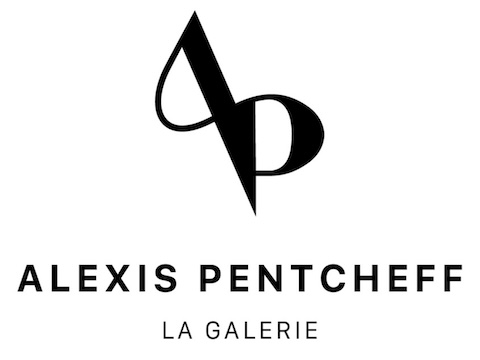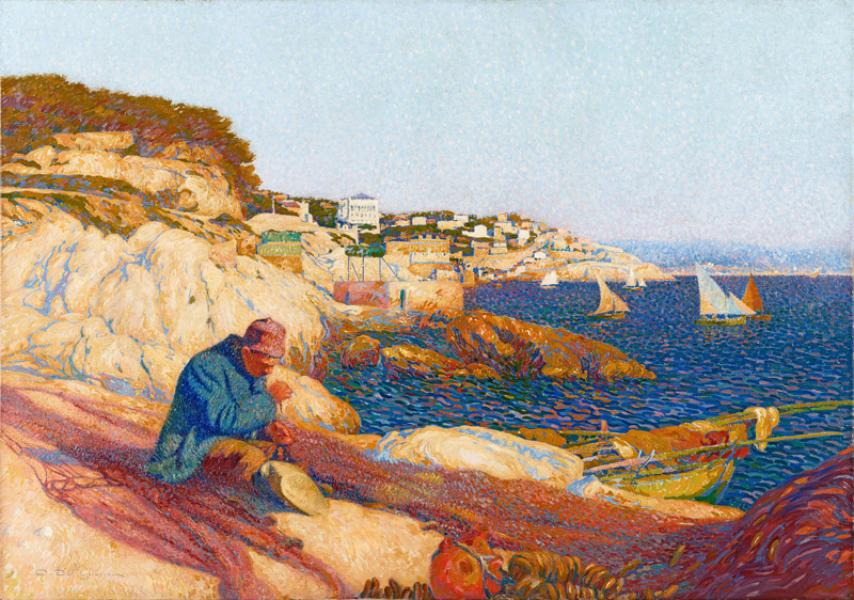Pêcheur raccommodant les filets, anse de Maldormé, Marseille
Oil on canvas, signed lower left.
100 x 180 cm
Provenance :
Private collection
FISHING ZONE
David Dellepiane knows Marseille's fishermen well, having grown up among them on the port in the Saint-Jean district. They're all Marseillais, but from different backgrounds. Most, like Dellepiane's parents, left Genoa, and many others came from Naples (in 1914, nearly one in five inhabitants of Marseille was of Italian origin).
Barely settled in as a painter, on his return from the capital where he had worked in Jules Chéret's studio, it was on the port, which was familiar to him, that he set up his studio, quai du Canal, in 1890. But the artist was not simply an observer, sketching the boats docked in the basin.
He's an experienced sailor, a fine helmsman and a fervent regatta competitor. A sedentary but adventure-loving sailor, he named his yacht Vagabond. Built by his brother Jean-Baptiste from the artist's own plans, it was moored at the Société Nautique de Marseille from 1913 onwards. Weather permitting, Delle explores the harbor in the fullness of silence. As a passionate sailor, Dellepiane never tired of evoking the Mediterranean and its wealth of riches in his paintings.
More broadly speaking, his inspiration from Marseilles was ever-present in his work as a painter, poster artist and illustrator. Sometimes taking on the mythical appearance of its founders Gyptis and Protis in the poster commemorating the twenty-fifth centenary of its creation, sometimes the features of a fisherman untying his nets, or the face of an Art Nouveau female muse personifying the famous Cannebière... in Dellepiane's work, Marseille is incarnate, Marseille breathes. The Vieux Port, the Corniche, Notre-Dame de-la-Garde, even if only sketched, are enough in themselves to invoke the soul of Marseille. A fiery, secular, popular soul, stirred by the Mediterranean. Marseille's children are loyal and cheeky, nurtured by the Bonne Mère who embraces the harbor.
With all his poster artist skill, Dellepiane leads us here in the dying sun to a fisherman busy mending his nets. On the flat rocks of the Corniche, not far from his moored boat, a man is at his task, silent and diligent. Back from fishing, using a large needle or a special shuttle, he is busy re-stitching his nets, spread out in the sun. The upkeep of the nets, then made of cotton, was a major part of the work on land. Not only did the nets have to be refurbished after fishing, they also had to be taken to the dyeing plant in a wheelbarrow every week for treatment, as they tended to go mouldy. In Marseilles, the Chaudron de l'Estaque dyeing plant was located in the fishermen's prud'homie. Basins built into the floor of this factory were used to soak the nets in a decoction of pine bark, ground to a powder and then boiled in large copper pots, which had the virtue of making them rot-proof.
This painting is a variant of a larger one by the artist, measuring 184 x 247 cm (ours measures "only" 100 x 180 cm), acquired by FRAOP, the Fonds Régional d'Acquisition d'Oeuvres Provençales. Apart from a few minor details, the motif and composition of our painting are strictly identical. This practice of multiples was a habit of the artist. Sometimes varying in framing, the same motif was a multiple subject of study for Dellepiane, and a third version of the fisherman gathering his nets on the Corniche is known to exist in a private collection, identical except that the format is vertical. An illustrator's habit of repeating an identical motif but with a new framing, to give it a new perception.
In Dellepiane's day, the best bouillabaisse was served at Roubion's on the Corniche. The establishment, a palace hotel, was renowned throughout Europe for this culinary specialty, the Palais de la Bouillabaisse proclaimed in the inserts it published in tourist guides: "Grand parc aux coquillages - Five o'clock tea - Vaste terrasse dominant la mer".
A tempting program. The restaurant's shellfish tank, nestled beneath the hotel, is so vast that the establishment is renamed "La Réserve". The Marseilles bourgeoisie gathered here, rubbing shoulders with tourists on luxury vacations. The physiognomy of the building is so distinctive, with its arched windows supported by Corinthian columns, that you can't help but notice it at first glance. The Reservation thus stands out, overlooking the Corniche at the height of the Prophets, in the picture we present.
But just as you don't have to sit at the opulent table at La Réserve to enjoy an authentic bouillabaisse, the pleasures of the seaside are not reserved for the more affluent, and there are plenty of little cabanons dotting the Corniche. On Sundays, they're the place to be for a swim or a family outing.
Whatever the setting of these Marseillais of the time, rich or poor, it has now disappeared: the Reserve, whose famous fishpond was sold in 1938, was completely destroyed in the second half of the 20th century to make way for a residential complex, and the sheds were razed to the ground to widen the Corniche road in the 1950s.
Dellepiane appears to us more as a privileged witness to a Marseille-style art of living, now partly dislocated.
However, our perception of the fishing net today is not devoid of a certain trepidation. In the 21st century, this classic attribute of the fisherman has taken on a more polemical dimension, given its impact on the environment. And yet, contrary to what one might think, this concern is nothing new.
As far back as Dellepiane's time, the scarcity of maritime resources had already raised awareness. Throughout the 19th century, attempts were made to regulate fishing practices using dragging gear. Foreign fishermen, especially Catalans but also Italians, were particularly accused of using and importing these invasive fishing methods, which damaged the seabed and depleted resources.
In 1894, the first marine protected area, i.e. the first no-fishing zone in France, was created in the Endoume district of Marseille. Unfortunately, this experiment was short-lived, but it shows that the challenge of protecting marine resources on our coastline is not new.

